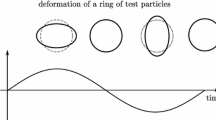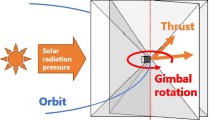Abstract
Space gravitational wave detection missions require low bandwidth, high accuracy and strong robustness for the drag-free satellite systems, which require laser interference experiments with dual test masses (TMs) inside the satellite. For drag-free control and electrostatic levitation control with dual TMs satellites, linear controllers are difficult to solve the comprehensive problems of high accuracy and stability. In this paper, fractional order active disturbance rejection control (FOADRC) is used as the drag-free controller and electrostatic levitation controller, in which the non-linear controller controls the drag-free system and the active disturbance rejection compensates the system with feedback, achieving the objectives of frequency division control and interference suppression for the drag-free control and electrostatic levitation control. The simulation results show that the relative displacement of the satellite and the test mass (TM) is less than \(1 \times 10^{ - 9}\,{\mathrm{m\,Hz}}^{ - 1/2}\) and the residual acceleration is less than \(1 \times 10^{ - 15}\,{\mathrm{m\,s}}^{ - 2}\,{\mathrm{Hz}}^{ - 1/2}\) in the sensitive band of 0.1 mHz–1 Hz gravitational wave detection. The designed controller scheme ensures the system robustness and control accuracy under the ultra-low bandwidth constraint and improves the system-response performance.





















Similar content being viewed by others
Data availability
The data that support the findings of this study are available from the corresponding author upon reasonable request.
References
Abbott BP, Abbott R, Abbott TD et al (2016) Observation of gravitational waves from a binary black hole merger. Phys Rev Lett 116(6):061102. https://doi.org/10.1103/PhysRevLett.116.061102
Hu Y, Zhang L, Gao Y et al (2022) Analysis of key technologies of spacecraft for gravitational waves detection in space. Spacecraft Eng 31(4):7. https://doi.org/10.3969/j.issn.1673-8748.2022.04.001
Wu S, Zhang Q, Liu M, et al. Key Technologies and progress of inertial sensors for space gravitational wave detection. Chin Space Sci Technol. http://kns.cnki.net/kcms/detail/11.1859.V.20221028.1701.002.html
Cai RG, Cao Z, Guo ZK et al (2017) The gravitational-wave physics. Natl Sci Rev 4(5):687–706. https://doi.org/10.1093/nsr/nwx029
Castelli E (2020) LISA Pathfinder noise performance results: disturbances in the sub-mHz frequency band and projection to LISA. https://doi.org/10.15168/11572_254388
Fichter W, Gath P, Vitale S et al (2005) LISA pathfinder drag-free control and system implications. Class Quantum Gravity 22(10):S139. https://doi.org/10.1088/0264-9381/22/10/002
Shi L, Cao X, Zhang J et al (2010) Survey of drag-free satellite. J Astron 31(06):1511–1520. https://doi.org/10.3873/j.issn.1000-1328.2010.06.001
Weber WJ, Cavalleri A, Dolesi R et al (2002) Position sensors for LISA drag-free control. Class Quantum Gravity 19(7):1751. https://doi.org/10.1088/0264-9381/19/7/371
Lange B (2011) The drag-free satellite. AIAA J 2(9):1590–1606. https://doi.org/10.2514/3.55086
Lange BO (1964) The control and use of drag-free satellites. Stanford University, Stanford
Maghami PG, Hyde TT (2003) Laser interferometer space antenna dynamics and controls model. Class Quantum Gravity 20(10):S273. https://doi.org/10.1088/0264-9381/20/10/330
Grynagier A, Fichter W, Vitale S (2009) The LISA Pathfinder drift mode: implementation solutions for a robust algorithm. Class Quantum Gravity 26(9):094007. https://doi.org/10.1088/0264-9381/26/9/094007
Pettazzi L, Lanzon A, Theil S et al (2009) Design of robust drag-free controllers with given structure. J Guid Control Dyn 32(5):1609–1621. https://doi.org/10.2514/1.40279
Canuto E (2008) Drag-free and attitude control for the GOCE satellite. Automatica 44(7):1766–1780. https://doi.org/10.1016/j.automatica.2007.11.023
Canuto E, Bona B, Calafiore G et al (2002) Drag free control for the European satellite GOCE. Part II: digital control. In: Proceedings of the 41st IEEE conference on decision and control, vol 4. IEEE, pp 4072–4077. https://doi.org/10.1109/CDC.2002.1185004
Canuto E, Massotti L (2009) All-propulsion design of the drag-free and attitude control of the European satellite GOCE. Acta Astronaut 64(2–3):325–344. https://doi.org/10.1016/j.actaastro.2008.07.017
Canuto E, Massotti L (2010) Local orbital frame predictor for LEO drag-free satellite. Acta Astronaut 66(3–4):446–454. https://doi.org/10.1016/j.actaastro.2009.06.016
Ziegler T, Fichter W (2007) Test mass stiffness estimation for the LISA pathfinder drag-free system. In: AIAA guidance, navigation and control conference and exhibit, p 6669. https://doi.org/10.2514/6.2007-6669
Fichter W, Schleicher A, Bennani S et al (2007) Closed loop performance and limitations of the LISA Pathfinder drag-free control system. In: AIAA guidance, navigation and control conference and exhibit, p 6732. https://doi.org/10.2514/6.2007-6732
Wu SF, Fertin D (2008) Spacecraft drag-free attitude control system design with quantitative feedback theory. Acta Astronaut 62(12):668–682. https://doi.org/10.1016/j.actaastro.2008.01.038
Wang E, Zhang J, Li H et al (2021) Relative position model predictive control of double cube test-masses drag-free satellite with extended sliding mode observer. Math Probl Eng 2021:1–15. https://doi.org/10.1155/2021/8887479
Zhang J, Dong X, Cao X (2014) An adaptive controller for drag-free satellites without velocity measurement. J Astron 35(04):447–453. https://doi.org/10.3873/j.issn.1000-1328.2014.04.011
Yang F, Tan S, Xue W et al (2020) Extended state filtering with saturation-constrainted observations and active disturbance rejection control of position and attitude for drag-free satellites. Acta Autom Sin 46(11):2337–2349. https://doi.org/10.16383/j.aas.c190515
Lian X, Zhang J, Lu L et al (2021) Frequency separation control for drag-free satellite with frequency-domain constraints. IEEE Trans Aerosp Electron Syst 57(6):4085–4096. https://doi.org/10.1109/TAES.2021.3088456
Ma H, Han P, Gao D et al (2021) H∞ robust controller design for deep space drag-free satellite with two test masses. J Harb Inst Technol 53(02):1–13. https://doi.org/10.11918/202006038
Giulicchi L, Wu SF, Fenal T (2013) Attitude and orbit control systems for the LISA Pathfinder mission. Aerosp Sci Technol 24(1):283–294. https://doi.org/10.1016/j.ast.2011.12.002
Acknowledgements
This work was supported by the National Natural Science Foundation (NNSF) of China under Grant (Grant No. 12162007), National Key R&D Program of China Key Project of Gravitational Wave Detection in 2020 (Grant No. 2020YFC2201000), and the Research on New Power System and Its Digital Engineering [grant number QianJiaoJi, China (2022) 043].
Author information
Authors and Affiliations
Contributions
Conceptualization, Y.S., J.Z., Y.G. and A.P.; data curation, Y.S. and J.Z.; funding acquisition, A.P.; investigation, J.Z. and Y.S.; methodology, Y.S., A.P., Y.G. and J.Z.; resources, A.P.; validation, Y.S., J.Z.; visualization, J.Z.; writing—original draft, Y.S., J.Z.; writing—review and editing, A.P. All authors have read and agreed to the published version of the manuscript.
Corresponding author
Ethics declarations
Conflict of interest
The authors declare no conflict of interest.
Additional information
Communicated by Donghun Lee.
Publisher's Note
Springer Nature remains neutral with regard to jurisdictional claims in published maps and institutional affiliations.
Rights and permissions
Springer Nature or its licensor (e.g. a society or other partner) holds exclusive rights to this article under a publishing agreement with the author(s) or other rightsholder(s); author self-archiving of the accepted manuscript version of this article is solely governed by the terms of such publishing agreement and applicable law.
About this article
Cite this article
Shao, Y., Pang, A., Zhou, J. et al. Nonlinear Active Disturbance Rejection Controller Design for Drag-Free Satellite with Two Test Massess. Int. J. Aeronaut. Space Sci. (2024). https://doi.org/10.1007/s42405-024-00739-z
Received:
Revised:
Accepted:
Published:
DOI: https://doi.org/10.1007/s42405-024-00739-z




